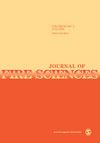粮食的辐射点火特性和点火时的表面温度
IF 1.9
4区 工程技术
Q2 ENGINEERING, MULTIDISCIPLINARY
引用次数: 0
摘要
粮食在储存、运输和加工设施中的防火安全要求了解其燃烧特性,本研究已确定了其中一些特性。研究了含水量为 10% 的豇豆、扁豆、小米、大豆、去壳花生、亚麻(亚麻籽)、葵花籽、去壳花生和芝麻。使用锥形量热计加热器对粮食施加 25、35 和 47.5 kW/m2 的辐射热流量,以确定引燃时间和点火时的表面温度 ( Ts,ig)。点火温度 ( Tig) 是根据实验确定的临界热通量计算得出的。此外,还计算了对确定食物颗粒点火特性至关重要的热反应参数和热惯性([公式:见正文])。热反应参数似乎最适合用来区分粮食的可燃性。点燃温度在 239°C 至 305°C 之间,而热反应参数在 261 至 565 kWs0.5/m2 之间。小颗粒大小的谷物显示出更高的可燃性。本文章由计算机程序翻译,如有差异,请以英文原文为准。
Radiative ignition properties of food grains and surface temperatures at ignition
Fire safety of food grains in storage, transport and processing facilities requires knowledge of their ignition properties some of which have been determined in this study. Cowpea, lentils, millet, soybean, unshelled peanut, flax (linseed), sunflower, shelled peanut and sesame, at 10% moisture content were studied. A cone calorimeter heater was used to impose radiative heat fluxes of 25, 35 and 47.5 kW/m2 on the food grains to determine the time to piloted ignition concurrently with the surface temperature at ignition ( Ts,ig). Ignition temperatures ( Tig) were calculated from experimentally determined critical heat fluxes. The thermal response parameter and thermal inertia ([Formula: see text]) essential for the characterization of the ignition of the food grains were also calculated. Thermal response parameter appears to be best suited for distinguishing the ignitability of the food grains. Ignition temperatures range between 239°C and 305°C, while thermal response parameter varies between 261 and 565 kWs0.5/m2. Small particle-sized grains showed higher ignitability.
求助全文
通过发布文献求助,成功后即可免费获取论文全文。
去求助
来源期刊

Journal of Fire Sciences
工程技术-材料科学:综合
CiteScore
4.00
自引率
0.00%
发文量
14
审稿时长
2.5 months
期刊介绍:
The Journal of Fire Sciences is a leading journal for the reporting of significant fundamental and applied research that brings understanding of fire chemistry and fire physics to fire safety. Its content is aimed toward the prevention and mitigation of the adverse effects of fires involving combustible materials, as well as development of new tools to better address fire safety needs. The Journal of Fire Sciences covers experimental or theoretical studies of fire initiation and growth, flame retardant chemistry, fire physics relative to material behavior, fire containment, fire threat to people and the environment and fire safety engineering. This journal is a member of the Committee on Publication Ethics (COPE).
 求助内容:
求助内容: 应助结果提醒方式:
应助结果提醒方式:


